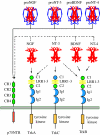Neurotrophin-regulated signalling pathways
- PMID: 16939974
- PMCID: PMC1664664
- DOI: 10.1098/rstb.2006.1894
Neurotrophin-regulated signalling pathways
Abstract
Neurotrophins are a family of closely related proteins that were identified initially as survival factors for sensory and sympathetic neurons, and have since been shown to control many aspects of survival, development and function of neurons in both the peripheral and the central nervous systems. Each of the four mammalian neurotrophins has been shown to activate one or more of the three members of the tropomyosin-related kinase (Trk) family of receptor tyrosine kinases (TrkA, TrkB and TrkC). In addition, each neurotrophin activates p75 neurotrophin receptor (p75NTR), a member of the tumour necrosis factor receptor superfamily. Through Trk receptors, neurotrophins activate Ras, phosphatidyl inositol-3 (PI3)-kinase, phospholipase C-gamma1 and signalling pathways controlled through these proteins, such as the MAP kinases. Activation of p75NTR results in activation of the nuclear factor-kappaB (NF-kappaB) and Jun kinase as well as other signalling pathways. Limiting quantities of neurotrophins during development control the number of surviving neurons to ensure a match between neurons and the requirement for a suitable density of target innervation. The neurotrophins also regulate cell fate decisions, axon growth, dendrite growth and pruning and the expression of proteins, such as ion channels, transmitter biosynthetic enzymes and neuropeptide transmitters that are essential for normal neuronal function. Continued presence of the neurotrophins is required in the adult nervous system, where they control synaptic function and plasticity, and sustain neuronal survival, morphology and differentiation. They also have additional, subtler roles outside the nervous system. In recent years, three rare human genetic disorders, which result in deleterious effects on sensory perception, cognition and a variety of behaviours, have been shown to be attributable to mutations in brain-derived neurotrophic factor and two of the Trk receptors.
Figures


References
-
- Arevalo J.C, Yano H, Teng K.K, Chao M.V. A unique pathway for sustained neurotrophin signaling through an ankyrin-rich membrane-spanning protein. EMBO J. 2004;23:2358–2368. 10.1038/sj.emboj.7600253 - DOI - PMC - PubMed
-
- Arevalo J.C, Pereira D.B, Yano H, Teng K.K, Chao M.V. Identification of a switch in neurotrophin signaling by selective tyrosine phosphorylation. J. Biol. Chem. 2006a;281:1001–1007. 10.1074/jbc.M504163200 - DOI - PubMed
-
- Arevalo J.C, Waite J, Rajagopal R, Beyna M, Chen Z.Y, Lee F.S, Chao M.V. Cell survival through Trk neurotrophin receptors is differentially regulated by ubiquitination. Neuron. 2006b;50:549–559. 10.1016/j.neuron.2006.03.044 - DOI - PubMed
-
- Bazenet C.E, Mota M.A, Rubin L.L. The small GTP-binding protein Cdc42 is required for nerve growth factor withdrawal-induced neuronal death. Proc. Natl Acad. Sci. USA. 1998;95:3984–3989. 10.1073/pnas.95.7.3984 - DOI - PMC - PubMed
Publication types
MeSH terms
Substances
LinkOut - more resources
Full Text Sources
Other Literature Sources
Molecular Biology Databases
Research Materials
Miscellaneous
